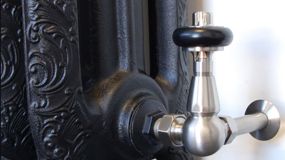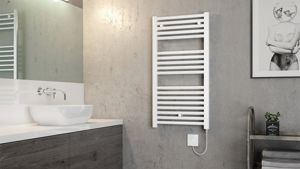Welcome to the Only Radiators blog, where this week we investigate the thermostatic radiator valve, or TRV.
An Introduction to Thermostatic Valves
The thermostatic radiator valve head is a quintessential piece of radiator technology. It is one of the many possible heating controls for modulating air temp across rooms. And due to its great value and easy function, it’s one of the most popular.
You will find or fit your TRV on the side of your radiator, and correct set-up enables you to maximise a single boiler and enjoy different heats across different rooms.
How do Thermostatic Radiator Valves Work?
The TRV is a valve that self-regulates, meaning it adjusts the flow of water into your radiator or heated towel rail depending on the setting.
The thermostatic valve head goes on top of the valve body. And as the room temperature changes, the valve head expands, adjusting a pin in the valve body so that it opens or closes.
Expansion as the room heats blocks the valve body to receive less hot water into the radiator.
Contraction as the room cools opens the valve body to receive more hot water into the radiator.
TRVs come in two main designs. They can be either wax or liquid models, with liquid thermostatic radiator valves being the more recent development. Their main bonus over wax thermostatic valves is providing quicker adjustment according to temperature changes.
Both wax and liquid thermostatic radiator valves offer automatic adjustment as opposed to your basic manual radiator valve.
Thermostatic Valves: Benefits and Drawbacks
The key benefit of thermostatic radiator valves is their energy saving potential. Make the most of your TRV settings to control individual room temperatures and save money by avoiding overheating commonly caused by manual valves.
The Customisable Perks of the TRV
Flexibility is the driver behind installing thermostatic radiator valves in your home. Avoid energy wastage and prevent frost damage, mould and other climate-based issues that can plague home maintenance. Here’s two key scenarios…
In busier rooms like your lounge – heated more by your family’s movements, appliances and even the sun shining through the windows – the TRV can be set at a lower temperature. Your TRV will restrict water flow as the right heat is reached, and you will avoid overheating your home’s areas that are naturally hottest.
Then in less populated rooms like spare bedrooms or exterior communal areas, you can set the TRV even lower and avoid heating rooms not used as often by your family.
Thermostatic radiator valves show their economic potential by enabling you to save money and fuel while enjoying a comfortably heated home.
Potential Thermostatic Radiator Valve Issues
With proper thermostatic radiator valve maintenance, there’s no drawbacks. However, it is possible to encounter issues.
Older thermostatic valves can easily be confused about a room’s temperature. Draughts or ventilation mess with the valve, causing much hotter or colder readings than reality.
And these simple devices can influence big knock-on issues depending not only on if they break but when they break.
If a thermostatic radiator valve stops working when turned off, the radiator will not switch on and can cause condensation, mould, frost damage and other cold-based issues. And if your TRV breaks when on, it will pump endless hot water through your radiator and cause serious overheating.
For this reason, perform frequent TRV checks to ensure accurate ambient heat detection, and do not leave them on high settings when out of the house for a significant period of time.
Bathrooms: A TRV No-No
Don’t make the mistake of installing a thermostatic radiator valve in your bathroom, as the heat produced by your shower or bath will wreak havoc with the TRV’s thermostat. Instead of preventing the condensation that often hinders bathrooms, the TRV will shut off and do nothing.
Another consideration is to not fit thermostatic radiator valves in the same room as your principal thermostat. This unit connects directly to your boiler and so you will inadvertently create a competition between your TRV and central thermostat. In this monumental battle, the only loser is the homeowner!
The Promise of the Modern TRV
Thermostatic radiator valves have come a long way since the basic wax valves. Now, we recommend TRVs to most of our customers due to their advanced technology, reliability and foolproof set-up. Behold, the electronic thermostatic radiator valve…
Leading home heating brands like Honeywell have taken the TRV further than ever. A battery-powered thermostat with more advanced heat detection ensures the TRV performs with greater accuracy than any traditional thermostatic radiator valve.
Electronic TRVs can also be connected to increasingly popular intelligent heating systems. With the ever-advancing possibilities of smart home systems and Internet of Things, you can now manage your TRVs using your smartphone from the comfort of your sofa – or even while travelling – to keep your home heating ticking safely at all times.
How to Fix Thermostatic Valves
Next, we cover the two main thermostatic radiator valve issues and how to fix them. If you need more in-depth advice, our friendly team is always available by phone for support.
TRVs are not complex items and diagnosis is usually very simple. Just take a few minutes to evaluate the situation before searching the net for “how to remove a radiator with a thermostatic valve?” and flooding your home when a simple fix would have sufficed.
How to Unstick a Thermostatic Radiator Valve?
A sticking valve is probably the most common thermostatic radiator valve issue. Whether open or closed, it’s going to cause real hassle in the long run. It usually happens when adjusting the valve for the first time in a long time, such as following an extended cold spell or the summer (often one and the same!).
To fix this, set your TRV to the highest setting then undo the thermostat removal nut by hand. You will uncover a piston that will usually spring up and compress down smoothly. Take some WD40 and apply a small amount until it moves smoothly once more.
A non-responsive piston means you should replace your TRV. Stay tuned until the end of this article when we present our selection of market-topping TRVs…
Thermostatic Valve Not Turning On or Off?
If the piston is moving smoothly but your TRV is not operating, the internals are likely kaput. It happens now and then, especially in older models, so take this opportunity to upgrade your home heating and benefit from proper TRV function. Fit a new TRV, confirm the valve works, and years of worry-free modulated heating should await you.
Avoid finding out your thermostatic valve is broken too late, as well as preventing a sticking TRV, by seasonally checking and lubricating your valve piston. It is also important to keep the vents around the valve head free of dust and other debris as these may lower the accuracy of your TRV readings.
Are TRVs Worth Having in my Home?
Absolutely! In a property with multiple radiators heating rooms of varying traffic, thermostatic radiator valves are a no-brainer! Heat where you want, no wastage where you don’t.
With the simple maintenance we mentioned, your TRVs will function flawlessly for years. And if you have an intelligent home heating system, a set of electronic thermostatic radiator valves will be your best move for significant energy and money savings.
Help the environment by heating your own with greater consideration. This is why our government is encouraging TRV use across new building regulations. We at Only Radiators care deeply about the preservation of our planet – for this reason, we totally endorse TRVs!
Our Range of Thermostatic Radiator Valves
Browse our full selection of radiator valves and discover the perfect product for your home heating today.
For now, let's take a peek at a few of our best sellers..
Your Leading Heating Source
As always, keep checking up on the Only Radiators blog time and time again for industry-leading home heating ideas, and sign up to our newsletter for exclusive news, money-saving tips, competitions and much more!








